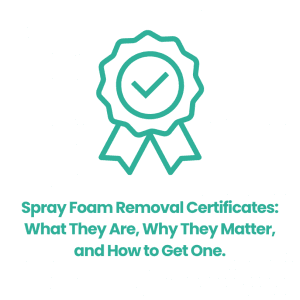Spray foam insulation can improve energy efficiency — but when it’s time to sell, it often becomes a problem. Many UK homeowners discover the hard way that spray foam can block a sale, especially when surveyors raise red flags or lenders refuse to offer a mortgage.
So, here’s the question we hear all the time:
“Do I have to remove the spray foam to sell my home?”
Let’s break it down.
Yes, You Can Sell — But It Depends
Selling a home with spray foam insulation is possible. But whether you can sell it easily or at full market value depends on a few important factors:
The type of spray foam installed (open-cell vs closed-cell)
The quality of the installation
Whether documentation is available
Whether the buyer is using a mortgage
The lender’s policies and the surveyor’s findings
So while removal isn’t legally required, it may be the only way to complete your sale smoothly — and at full value.
When You Might NOT Need to Remove It
There are a few situations where you could sell a home without removing the spray foam:
✔ You’re Selling to a Cash Buyer
Cash buyers don’t need mortgage lender approval, so they can proceed even if spray foam is present. However, many will still lower their offer due to future lending concerns.
✔ You Have Full Documentation
If you can provide a pre-installation suitability report, installation guarantees, and possibly a post-installation moisture assessment, some lenders may consider it — particularly if the spray foam is open-cell and clearly not causing structural issues.
✔ The Foam is in Non-Structural Areas
If the spray foam is in walls or underfloor areas and not in the loft or roof, it may not trigger concerns. Roof spray foam is where surveyors tend to raise the most serious objections.
But in Most Cases, Removal Is the Only Way Forward
Here’s what usually happens when spray foam is present in the loft or roof:
The surveyor flags it as a high-risk item in the mortgage valuation report
The lender refuses the mortgage until the insulation is removed and the roof inspected
The buyer either pulls out or asks you to cover removal costs
The sale falls through or is significantly delayed
Even if everything looks fine, the lack of visibility to roof timbers alone is enough for a surveyor to raise
What If You Just Don’t Tell Anyone?
Failing to disclose spray foam insulation could come back to haunt you.
Buyers can pull out before completion
If the buyer later discovers it, they could pursue you for misrepresentation
It can affect future sales if not dealt with now
Transparency matters. It’s not just ethical — it’s practical.
How Spray Foam Removal Helps You Sell Faster
If your buyer needs a mortgage (and most do), removing the spray foam is usually the fastest, cleanest solution.
✔ Enables a full roof inspection
✔ Removes the most common survey red flag
✔ Broadens your buyer pool
✔ Helps retain your asking price
✔ Avoids last-minute fall-throughs
Yes, it’s a cost — but it’s often what unlocks the deal.
So… Should You Remove It Before Selling?
Ask yourself:
Is your buyer using a mortgage?
Do you have full paperwork from the installation?
Is the insulation causing condensation or damp issues?
Has a surveyor already flagged it?
Are you losing buyer interest because of it?
If you’ve answered yes to even one of these — removal may be your best route to a clean sale.
Need Help Deciding? Let Spray Foam Advice Guide You
Not sure whether to remove or disclose? We’ll help you make the right move.
Free expert consultation based on your property
Vetted removal partners who use lender-approved methods
Help with surveys, quotes, and post-removal certification
No obligation, no pressure
📞 Call us now: 020 7870 3965
📧 Email: contact@sprayfoamadvice.co.uk
✔ Get free advice before you make the next move

